| |
| ... |
|
|
|
|
|
| |
| May 26, 2008 |
|
Fossil Festival
Pat Young reports: Saturday morning's 15th Aurora Fossil Festival started with gray skies, chilly temps and heavy rain lasting until nearly noon. Collectors of all ages, wearing yellow parkas, (a few lucky ones had someone holding an umbrella over them as they collected) filled the Museum "Pit of the Pungo" -- rain apparently doesn't bother fossil hounds. Parade lovers lined the streets with umbrellas and outstretched hands waiting for candy treats tossed from floats. Community Center displays ran the gamut from NC minerals, whale fossils, a special display of fossil foot bones, river-found fossils and much more. The Smithsonian Institution reported a brisk business helping visitors identify finds. Under the Education tent, cold and wet participants kept smiles on their faces while talking with the public about such diversified subjects as dinosaurs (Patti Kane-Vanni), marine animals (National Aquarium-DC), and North Carolina's marine life (NC Aquarium). Tammy Ward's very friendly Western hognosed snake was a popular guest (children were allowed to handle it). Of special interest to PCS fossil collectors were two cetacean specimens from Calvert Marine Museum - a complete (fossil) dolphin skull (displayed in a plaster jacket) and a baleen whale jaw. Fossil vendors showed a great selection of fossils, minerals and related reference books. Rain cleared in the afternoon making the annual outdoor Fossil Auction a pleasant experience. Perennial auctioneer Jay Goldberg hawked his wares to the soft sounds of bluegrass music wafting under the canopy from a nearby tent. [Hopefully the last time the News will use that verb.]
One closely guarded secret this year was who our Fossil Master would be. Although not a fossil collector himself, Curtis Ormond, Sr. has long recognized the value of the good family fun collecting provides, as well as the scientific value gained. At times, when our presence at PCS would have been an added burden to daily operations, Curtis has remained steadfast in his commitment to our cause and has rather skillfully negotiated with other mine personnel to insure our continued access. It is entirely appropriate that he was named this year's Grand Marshall at the 15th Aurora Fossil Festival.
 Candace drove the bus for a special PCS sponsored "festival volunteer appreciation fossil hunt" on Sunday. With a larger than usual group and end of season tailings, one expects only mediocre results (this is primarily a social event). However, several previous weeks of rain and weathering provided this year's participants a bonus with an abundance of outstanding fossils. Collectors appeared to work the Yorktown and Pungo equally and everyone found a varied collection of shark teeth. Three large Carcharocles megalodon were found with Dave Sanderson's 5+ inch upper the largest (Fig. B); Tony Holt and George Diaz got 4+ inchers. Many smaller megs/chubutensis were found, including a nice example by Tom Caggiano (Fig. A) and Kevin May. Of the more unusual shark teeth found, Paul Sangeorzan and Jim Mahoney got upper Parotodus benedini teeth (2-1/2"), Maria Gerber a lower Hexanchus, Eric Sadorf Squatina sp. & Carcharoides catticus and an Alopias "latidens" by Candace. Several 2-1/2 " Cosmopolitodus hastalis lowers were found. Candace drove the bus for a special PCS sponsored "festival volunteer appreciation fossil hunt" on Sunday. With a larger than usual group and end of season tailings, one expects only mediocre results (this is primarily a social event). However, several previous weeks of rain and weathering provided this year's participants a bonus with an abundance of outstanding fossils. Collectors appeared to work the Yorktown and Pungo equally and everyone found a varied collection of shark teeth. Three large Carcharocles megalodon were found with Dave Sanderson's 5+ inch upper the largest (Fig. B); Tony Holt and George Diaz got 4+ inchers. Many smaller megs/chubutensis were found, including a nice example by Tom Caggiano (Fig. A) and Kevin May. Of the more unusual shark teeth found, Paul Sangeorzan and Jim Mahoney got upper Parotodus benedini teeth (2-1/2"), Maria Gerber a lower Hexanchus, Eric Sadorf Squatina sp. & Carcharoides catticus and an Alopias "latidens" by Candace. Several 2-1/2 " Cosmopolitodus hastalis lowers were found.

Of the other fossils found, seal seemed especially abundant for this season. Tracey Mayo got the only tooth, a nice molar (Fig. E) but Marc Griffin came away with a distal phalange, Jim Smith a caudal vertebra, and Joel Hardin a small femur; several metacarpal bones were seen. At least five crocodile teeth were found (Jim Mahoney, Fig. D) as well as some nice cetacean teeth. Mel Gulotto's black sperm whale tooth was nearly 6 inches with a 3 inch diameter. George Diaz dug around a barely exposed circular bone and was rewarded with a perfect 10" whale radius. Fish fossils were best represented by John Keklak's nearly complete Pogonias cromis lower pharyngeal tooth plate (Fig. C) and Joel Hardin's black wahoo jaw with three teeth. One small barracuda jaw and several extremely large tuna hypural bones were seen. Dave Bohaska came prepared for fossils; he returned to the bus with a plaster cradle holding a small bird skeleton. Other bird bones found were two ulnas (Brent McGuirt and Bob Asreen) and an Auk coracoid (Trish Kohler). Anne Lineberry got the only complete echinoid - a large Psammechinus philanthropus. It's a fair bet that at least part of this area will be available for fall season and we certainly anticipate the beginning of next season.
With the various weather related problems this fossil season has held, we owe a special thanks to those mine employees who have gone beyond the call of duty to keep the mine open to collectors. To Curtis Ormond Sr. and Jr. and Rob Jenner of the Mine Dept., we thank you so much for all the extra time and effort you put into making our season successful. Thanks also to BJ Blake for assistance with the fossil news reporting this spring.
Editor's note: Lest we forget, I'm sure you'll join with me in thanking Pat Young for her dedicated reporting and other efforts, particularly in such a trying season.
|
| |
| May 11, 2008 |
|
Weekend 11 -- Alternative tailings
Pat Young reports: After a rainy on-again, off-again week, PCS allowed Saturday's group to use the re-built ramp in the area collected last year rather than risk repairing the other. A view from the ramp showed plenty of well-weathered gullies and the lack of recent footprints was refreshing. With mine permission, we were allowed to cross a small dried patch of reclaimed land to get to the collecting area. Although only four hills were available, they seemed to produce like a much larger area. Today's visitors included members of Dry Dredgers Fossil Club (OH), Catawba Valley Gem and Mineral Club (NC), Delaware Valley Paleontological Society (DE), JHU-APL Fossil Club (MD), Low Country Fossil Club (SC) and a new to Aurora group - the Cypress Point Fossil Club (VA). The weather was pleasant and breezy most of the day.
Because I had to leave the mine before the last bus out, I received most information through the fossil grapevine. By all accounts, Richard Aultman got the largest tooth of the day. a 5+ inch Carcharocles megalodon that was nearly as wide (Becky reported it was in excellent condition). Nice megs in the 3 to 4-inch range were found by George Powell, Mark Ladd (nice lower), Sammy Peek and Ken Young; a pathological was collected by Dan Furimsky. Small C. chubutensis teeth (fairly plentiful in the 1-inch range) were extremely colorful and well preserved; Bob Bross found two which are to be a gift for his son Taylor's, 16th birthday. Broad-form hastalis, tiger shark, Notorynchus lowers and Hemipristis teeth found their way into most collectors' bags. Those collecting the Pungo limestone reported an abundance of both the "usual suspects" and a variety of dolphin/porpoise teeth; surprisingly, no Echinorhinus teeth were seen. The lone Parotodus benedini tooth, fittingly enough, went into George Powell's collection. Marine mammal collectors reported many whale teeth; John Keklak's Squalodon molar (image) was the best find of the day. Tom Sprecht got the largest sperm whale tooth and Baxter Leonard's unerupted tooth the smallest. Ken Young and Baxter found Squalodon incisors. Although no seal teeth were seen, Richard Aultman got a metatarsal and Wayne Godley two phalanges. Other vertebrate fossils included turtle bones & scutes, several cetacean humeri, bullas & periotics, sturgeon skin plates, bird bones, two crocodile teeth and two billfish rostrums.
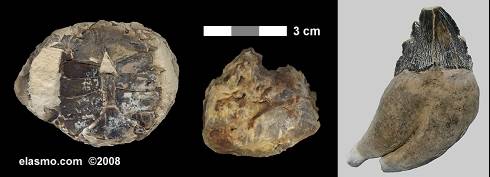
Invert collectors had nearly as prolific a day. Although this area had never been great for shell collecting, the rain and lack of traffic permitted some nice articulated specimens to survive. Several buckets left the mine filled with dinner plate-sized pectens and perfect gastropods. Eric Fritz got an Echinocardium kelloggi and Tom Bantel a Psammechinus philanthropus. The fossil of a small swimming crab (image) was plucked from the small patch of reclamation allowed us. This dirt typically consists of tailings from the top 35 or so feet of overburden (James City Fm). A golf ball-sized piece of opaque amber (image) was picked from the ramp.
Today's wide variety of fossils is the reason we all keep coming back to Aurora.
|
| |
| May 8, 2008 |
|
Sunday canceled
Curtis Ormond Jr. advises: The NC weather forecast for this weekend is calling for thunderstorms Sunday morning. To save fossil collectors the time and expense involved in traveling to Aurora and possibly getting rained out, I'm cancelling the trip scheduled for Sunday. I apologize for any inconvenience this might cause. Please apply for collecting slots in the fall between the dates of August 15 and August 30. Saturday's trip will proceed as planned.
|
| |
| May 7, 2008 |
|
Ramp status
Pat Young notes: Curtis assured me that the mine ramp is going to be in good working order for this weekend. Now if only the rain will hold off. (There is no hunt scheduled for the weekend of May 17-18.)
|
| |
| May 7, 2008 |
|
Aurora Fossil Festival
Pat Young reminds: The 15th annual Aurora Fossil Festival will be held on May 23-24. Opening ceremonies wil be held at 6pm Friday with a street dance to follow. Saturday festivities start at 8am; the parade begins at 11am.
The Community Center and the Science Education tent will feature fossil, mineral and interactive displays by various fossil clubs and museums. Long time Lee Creek fossil collectors from Delaware Valley Paleontological Society, American Fossil Federation, Aurora Fossil Club, North Carolina Fossil Club, Catawba Valley Fossil Cub, Calvert Marine Museum Fossil Club, National Aquarium (DC), NC Maritime Museum and others will be displaying their collections. Bring those items you need help identifying and you'll have expert assistance from the North Carolina State Museum of Natural Sciences, Smithsonian Institution and Virginia Museum of Natural History. The day's special speakers and their topics are: Lauck Ward (VMNH) speaking on the geology and invertebrate fossil fauna of eastern NC, Dave Bohaska (SI) on whale evolution and Alton Dooley (VMNH) on Squalodon. Patti-Kane Vanni (DVPS) will present a dinosaur program at the Education tent. Fossil and mineral vendors will be situated at various places around town with a wide variety of paleo-related items. PCS is again offering free bus trips to tour the phosphate mine and are supplying "new" fossil dirt at several places for your convenience. Jay Goldberg will continue his tradition as Auctioneer for the Annual Fossil Auction. Many unusual vertebrate fossils are available as well as a nice selection of megalodon & Squalodon teeth and some rare fossils (some Native American artifacts are also up for auction). The auction starts at the museum Learning Center at 3pm sharp but plan to sign in and preview early. Expect the other typical festival doings---carnival, boat show, hot air balloon rides, petting zoo and dunkin' booth as well as plenty of good music and food.
|
| |
| May 6, 2008 |
|
Goblin shark tooth-set
The May issue of the NJPS Paleontograph includes an article proposing a
Scapanorhynchus tooth-set. For those interested in this taxon, download a PDF (0.5 mb) of this file.
|
| |
| May 1, 2008 |
|
Weekend 10 - Cancelled
The Sunday pm weather that terminated last weekend's collecting took a greater toll on the ramp than might have been expected -- the reconstructed portions of the ramp were gone and the overall condition worse than a week ago. Curtis Jr. indicated there was no way to rebuild it time for this weekend and that collecting would be canceled. No commitment could be given that repairs would be made in time for weekend 11.
|
| |
| April 27, 2008 |
|
Weekend 9 -- A Nearly complete weekend
Pat Young reports: In addition to nice spring weather, this weekend's mine visitors enjoyed a new ramp. We are all extremely grateful to Rob Jenner and his PCS crew who expended considerable time and effort to build us safe access to the pit (in spite of Mother Nature's other plans). Broader, less steep and constructed primarily of reject tailings, it provides solid footing and stands a good chance of providing some nice (surface collected) shark teeth as well. Saturday's group consisted of members of the Beaufort Maritime Museum, Tarheel Gem and Mineral Club, Coastal Carolina Community College (all NC) and several family groups. Special PCS guests included five collectors (image) from the Netherlands on their first USA fossil hunt. Sunday collectors were represented by Richmond Gem and Mineral Society (VA), Educators of Excellence Fossil Club (NC), Gem, Mineral and Lapidary Society of Montgomery County (MD) and individuals.

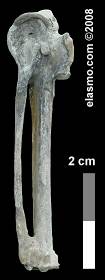 Although Aurora had some rain the previous week, it seemed to have little effect on Saturday's results. I heard of, but did not see, a 5-inch meg that had split down the middle. Most collectors apparently worked Pungo tailings, resulting in small chubutensis; Joseph Sink and Renee van Neer found nice 2-1/4 inchers. Two large broad-form hastalis were reported, a 3" upper (Gregg Walden) & a 2-1/4" (Brian Sink) and Dan Furimsky a 1-3/4" Parotodus benedini. Other tooth finds were the usual suspects; the Dutchmen did report they were quite happy to find an abundance of Hemipristis teeth, an uncommon find in their homeland. Unusual Saturday finds included Madelyn Culp's echinoid Psammechinus philanthropus (first of season), Gregg Walden's complete bird wing bone (cf Alca antiquua, carpometacarpus -- image), Ditchweezil's bramble shark tooth, Eric Sadorf's Carcharoides cattitus and BJ Blake's Brotula sp otolith. Allison Gleason-Besch and Cindy Clemenic got large whale teeth while several smaller ones were also reported. Candace Holliday's sharp eyes netted her a huge and nearly complete baleen whale bulla. Bryan and Lisa Blanton spent the day digging the Yorktown (image), netting them a nice marlin hypural, cetacean flipper bone and complete vertebra. (What initially appeared to be a skull turned out to be "just bone frags"; Bryan reported the exercise was good anyway). Although Aurora had some rain the previous week, it seemed to have little effect on Saturday's results. I heard of, but did not see, a 5-inch meg that had split down the middle. Most collectors apparently worked Pungo tailings, resulting in small chubutensis; Joseph Sink and Renee van Neer found nice 2-1/4 inchers. Two large broad-form hastalis were reported, a 3" upper (Gregg Walden) & a 2-1/4" (Brian Sink) and Dan Furimsky a 1-3/4" Parotodus benedini. Other tooth finds were the usual suspects; the Dutchmen did report they were quite happy to find an abundance of Hemipristis teeth, an uncommon find in their homeland. Unusual Saturday finds included Madelyn Culp's echinoid Psammechinus philanthropus (first of season), Gregg Walden's complete bird wing bone (cf Alca antiquua, carpometacarpus -- image), Ditchweezil's bramble shark tooth, Eric Sadorf's Carcharoides cattitus and BJ Blake's Brotula sp otolith. Allison Gleason-Besch and Cindy Clemenic got large whale teeth while several smaller ones were also reported. Candace Holliday's sharp eyes netted her a huge and nearly complete baleen whale bulla. Bryan and Lisa Blanton spent the day digging the Yorktown (image), netting them a nice marlin hypural, cetacean flipper bone and complete vertebra. (What initially appeared to be a skull turned out to be "just bone frags"; Bryan reported the exercise was good anyway).

Most Aurora collectors head quickly to the farthest corners and work their way back. A less frenzied approach on Sunday allowed Russ Byers a glimpse of a tooth tip which turned out to be a near perfect 4-1/4 " meg (image) spotted in freshly overturned ramp tailings; that 8:20 am find was the only large meg reported. Some nice Yorktown "makos", tigers and Notorynchus were collected but the bulk of the day's finds were Pungo teeth. Other interesting finds were a 4-1/2" anterior section of Istiophorus sp (sailfish) rostrum (Alex Laskovitch), ?walrus phalange (Sam Wheeler, image), barracuda jaw with 2 teeth (Krissie Hadley) and large dolphin tooth (Sharon Yomtob). Although the sizes seem to be getting smaller, quite a few whale vertebrae were collected.
Pamlico River storms, well known for forming quickly and furiously, put an early end (2:15pm) to the delightful weather Sunday's collectors had been enjoying. Sharp lightning and a loud thunder clap were soon followed by torrents of rain; fortunately it held off long enough for most to get to their cars. A 6 pm check of my rain gauge showed 4-1/4 inches and it was still falling at 7:30; that might be nice for next weekend's collectors.
|
| |
| April 25, 2008 |
|
Ramp Update II
Upon return after some mediocre Castle Hayne (Lutetian) collecting, I found an IM from Pat saying, "Just heard from Mine Super -- it is the schedule for the ramp to be repaired tomorrow (Friday) and fossil hunting should be a "go" for the weekend." Looking at the weather forecast, Saturday certainly looks good.
|
| |
| April 23, 2008 |
|
Ramp Update
As of Wednesday evening, there was no new ramp and no way to confirm it was scheduled to be completed by week's end. Had it been finished, it could already have been washed out - it's rained all week. I'll be on the road through Friday pm, so I'll have no way of posting any additional updates.
|
| |
| April 17, 2008 |
|
Weekend 8 - Cancelled
Curtis Ormond Sr. advises: "Both days of this coming weekend's fossil hunt are cancelled due to unstable access ramp conditions. PCS mine, safety and maintainence personnel are working on repairs and expect to have the ramp in proper condition for next weekend's hunt. Please check back here for any further developments."
|
| |
| April 13, 2008 |
|
Weekend 7 - Riders on the Storm
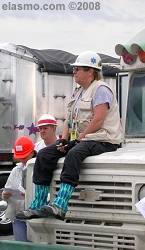 Jim Bourdon reports: Saturday's weather, originally forecasted by the WeatherChannel to be T-storms, had concerned many of the weekend's visitors. Heavy Saturday rains could have washed-out what was left of the access ramp; good news no rain, bad news of course was un-refreshed tailings.
Jim Bourdon reports: Saturday's weather, originally forecasted by the WeatherChannel to be T-storms, had concerned many of the weekend's visitors. Heavy Saturday rains could have washed-out what was left of the access ramp; good news no rain, bad news of course was un-refreshed tailings.
A two bus-sized group of collectors (Aurora Fossil Club, Eastern Missouri Fossil Society and non-affiliated) patiently listened as the new Beckymobile hood ornament went through the rules & regs, then patiently started boarding. I mention this only because unlike Friend's weekend visitors, the first group was allowed to collect immediately, thus insuring that the patient would not inherit the best areas. By my own experience, it wasn't 'til after eleven that I found fresh tailings five hills out (little worked Pungo). I never came across any Yorktown that hadn't been crossed and re-crossed. What would have been a hot day remained comfortable with the help of overcast skies and winds occasionally gusting to blow-you-down force (still went through two bottles of water).
The day's results tended to be mediocre - no big megs and a single decent "mako". My favorite was Marsha Painter's Pungo broad-form hastalis (2-1/4", fig. A). This is not the inflated hastalis narrow-form, but the labio-lingually compressed form that Agassiz originally called xiphodon. They are regularly found in the Yorktown but scarce in Middle Miocene Pungo sediments. Added to the scarcity was the condition and beautiful black and white coloration - a photographer's nightmare. Another great find was Jerry Messick's Parotodus benedeni (1", fig. C); based on basal profile it appeared to be an upper third anterior. Candace Holliday (possibly in repayment for her new role) was rewarded with a beautiful, near-perfect, Carcharoides catticus upper lateral (1/2", fig. B); worthy of note with this specimen were the secondary accessory cusplets on each side.

Besides the normally collected fossils, there were: Doug Jeffcoat's ray caudal scute with spine (1-1/2", fig D), Becky Hyne's Notorynchus symphyseal, astraguli (Becky ?walrus & Jerry Messick seal) and Howie Cohn's shark rostral node.
Sunday started with pleasant temperatures in the 60s for the day's collectors from the McDowell Co. Schools (VA) and various individuals. It turned into a beautiful day -- mid-70s, light breeze and the occasional cloud. The lack of a previous day's rain and less experienced collectors resulted in the season's first Pungo Crawlathon with corresponding results. Standing out this day were Glenn Hayes' Squalodon incisor (2-3/4"), John Steffensen's associated baleen whale periodic & bulla (4") and nearly a half dozen large (5-inch and greater) sperm whale teeth. If there's no rain this week, pack your kneepads
|
| |
| April 6, 2008 |
|
To rain or not to rain
Pat Young reports: Those watching the weather forecast earlier in the week had counted on rain starting Saturday afternoon. Instead, rain began Friday night and continued intermittently throughout most of Saturday; thunder and lightning sealed the fate for collectors gathered in the parking lot -- no mine trip would be possible. Although coming from New York, West Virginia, Maryland and other far parts, most accepted their bad luck with minor grumbling and spent some time collecting the parking lot where two Carcharoides catticus were found; they later visited the museum pit. Sunday's group fared better; after a trip to inspect the fossil ramp, it was determined to be safe to enter. What had formerly been a superhighway of sand had now become barely more than a cart track, but no one complained. Comfortable 58-degree temperatures, the lure of freshly washed tailings and lack of visible footprints transcended any muddy inconvenience. Saturday's visitors included National Capitol Fossil Club (DC) and Calvert Marine Museum Fossil Club (MD); Sunday's group included members of the New Jersey Paleontological Society (NJ) and North Coast Fossil Club (OH).

Most collectors quickly headed toward the newer areas to the left but even the older tailings produced well. Lana Regel spent the entire day on a small Pungo hill and found a completely exposed 3+ inch Carcharocles megalodon among many other nice fossils. A peek in her collecting bags confirmed her assessment of the days take - "phenomenal and best ever". Joining her later in the day, her husband Paul and I also found megs. Those collecting the Yorktown did well with the largest teeth being a stunning 5-1/8 inch meg found by Mike Mickey (Fig. A, also a 3-1/8"), a five-incher by Clay Whitehurst and a near perfect 4-inch tooth (Fig. B) found by Kevin May. The smallest meg was found by Rich Johnson - a pristine, 1 inch, blue-gray Pungo posterior; Chris Ryan's chubbie (Fig. D) lateral was also a beauty. One Isurus retroflexus (Paul Regel) was found but large makos and Cosmopolitodus, such as Chris Ryan's 2-1/2-incher (Fig. C), were abundant. Dave Sanderson and Margo Williams each got 2-inch Parotodus benedini teeth and nearly everyone found a nice Notorynchus. Ken Young's partially serrate meg (a patho?; Fig. F, mesial edge digitally repaired) drew quite a bit of interest. No one bothered to report small teeth although most bags were bulging from the finds.
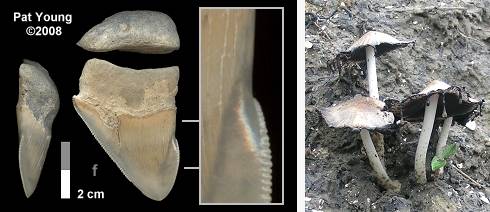
Marine mammal fossils were nearly as abundant with large whale teeth and vertebrae heavily collected. Chris Ryan (Fig. E) and Paul Regel each got Pilot whale teeth (Globicephala sp.- dolphin) and Chris got three associated sperm whale teeth. The only seal fossil, a calcaneum, was reported by John Timmerman; he also picked up a marlin rostrum. Several Squalodon teeth were seen, but Teresa Muller's complete incisor was best. Among unique items collected today, George Powell found a tennis ball size piece of amber and a 3" Mantis shrimp (Squilla empusa) abdomen (Pleistocene). Chris Ryan's stingray scute enamel was shaped like an angel with outstretched wings. Reggie Titmus disturbed a quarter-sized green turtle from hibernation; it will be moving to South Carolina for a new home in Reggie's biology classroom. As soon as a fossil is reported uncommon, they seem to multiply. Paul Regel and John Timmerman each recovered Fasciolaria cronlyensis shells today.
Freshly disturbed soil and warm rain provided perfect growing conditions for these Shaggy Mane (Coprinus comatus, see image) mushrooms sprouting at the top of the ramp. Their spores likely came from a crop growing at the edge of the woods.
|
| |
| April 2, 2008 |
|
Mystery Bone Solved?
Robert Boessenecker writes: "It is a proximal tibia from Ontocetus emmonsi, the Atlantic Pliocene walrus. Ontocetus used to be known as Alachtherium sp. (the adult) and Prorosmarus alleni (the juvenile). It's not from a phocid because the tibia and fibula are not fused proximally in this specimen, and its a bit on the big side."

|
| |
| April 1, 2008 |
|
Weekend 5 - A Weatherin' Weekend
Saturday (March 29) -- BJ Blake reports: In 52 degree weather, 52 intrepid NCFC members gathered in the windy parking lot. Despite the cloudy skies, hopes were high before entering the mine. We have not had much rain, just a sprinkle, so everyone was relying on the wind to have exposed the fossils. Winds can be fickle, but the variety collected today showed the "fossil gods" can be fickle as well. The quantity of the "usual suspects" was not at all disappointing, and some unusual finds were made as well.
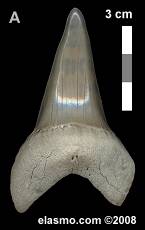 Larger Cosmopolitodus hastalis (broad-form) seem to be making themselves known: Donna Dickensen (2-1/2" upper), Kevin Blanton (2-7/8" lower) and Nancy Brown (3" lower, Fig. A). Dennis Hess showed a pristine 1-15/16" seal canine. Ron Krantz's 1-3/8" porpoise tooth of the same shape confused some (namely me), into thinking it was a seal tooth as well (but still a nice find); he also brought out 2 megs (2-3/4", 1-3/4"). Other megs included those by Mark Bennett (4-7/8" upper lateral), Jeff McGrady (3-7/8"), Michael Ford (2-1/4"), Jay Coe (3 & 2"), Donna Dickensen's sweetest "last posterior tooth" (1-1/4" wide) and others. Larger Cosmopolitodus hastalis (broad-form) seem to be making themselves known: Donna Dickensen (2-1/2" upper), Kevin Blanton (2-7/8" lower) and Nancy Brown (3" lower, Fig. A). Dennis Hess showed a pristine 1-15/16" seal canine. Ron Krantz's 1-3/8" porpoise tooth of the same shape confused some (namely me), into thinking it was a seal tooth as well (but still a nice find); he also brought out 2 megs (2-3/4", 1-3/4"). Other megs included those by Mark Bennett (4-7/8" upper lateral), Jeff McGrady (3-7/8"), Michael Ford (2-1/4"), Jay Coe (3 & 2"), Donna Dickensen's sweetest "last posterior tooth" (1-1/4" wide) and others.
Not to be outdone, Matt Rever came up and showed his half of a meg with a beautiful neck, great blonde enamel with a few hydration cracks -- one of those "heartbreakers" we all seem to experience. Later, Trish Kohler would show her finds, which included of all things, half of a beautiful blonde meg. Lo and behold, when placed together, they fit perfectly! It was a case of "what are the odds?" ... then, as they say, "the rest of the story". Those two were hunting together when Trish found her half in the early morning; despite digging she did not find any more. Late in the day when returning to the bus they stopped at the same hill and tried again. Matt pulled the matching half out with one rake stroke. Being the gentleman that he is, and after a good laugh, he gave the 2nd half to Trish with the promise that she will show him the complete repaired tooth.
Despite the temperature barely flirting with 50, and the winds increasing to 30-35 mph, some of the other interesting find included: Diane Willis & Mark Bennett Squalodon incisors, Carl Willis & Nancy Brown bird bones, Matt Rever & Eric Sadorf Carcharoides catticus teeth, Jennifer Hamby a nice 1-5/8" C. carcharias, Roxada Story a ray scute (scutes were my "prey for the day" without success, so forgive my envy please), John Steffensen an egg-sized hypercalcified ?suprascapula and Joanne Panek-Dubrock a shark rostral node.

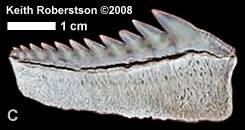 Although all the day's finds made the collectors happy, two fossils received special attention. Jeff McGrady's awesome and nearly perfect eleven cusp 1-7/8" Hexanchus (Fig. C) - certainly an enviable find. Joanne Panek-Dubrock got the "mystery mammal bone" (Fig. B) of the day. The articulating end of the bone raised speculation of everything from baleen whale jaw , to distal femur or proximal tibia or proximal fused tibia/fibula of a seal or walrus or camel or llama or mammoth or mastadon or..... well, I think you get the idea about why we called it the "mystery bone". Everyone who saw it today, (with comments ranging from "wow" to "whoa" to "huh?" to "what the ???" ) was interested in knowing what it is. Joanne plans to bring it to the Fossil Festival if she's not identified it before then, so stay tuned, and when it's identified, we will let you know! Although all the day's finds made the collectors happy, two fossils received special attention. Jeff McGrady's awesome and nearly perfect eleven cusp 1-7/8" Hexanchus (Fig. C) - certainly an enviable find. Joanne Panek-Dubrock got the "mystery mammal bone" (Fig. B) of the day. The articulating end of the bone raised speculation of everything from baleen whale jaw , to distal femur or proximal tibia or proximal fused tibia/fibula of a seal or walrus or camel or llama or mammoth or mastadon or..... well, I think you get the idea about why we called it the "mystery bone". Everyone who saw it today, (with comments ranging from "wow" to "whoa" to "huh?" to "what the ???" ) was interested in knowing what it is. Joanne plans to bring it to the Fossil Festival if she's not identified it before then, so stay tuned, and when it's identified, we will let you know!

Sunday (March 30) -- Pat Young reports: Traveling to the mine on Sunday, the view from Highway 306 revealed a morning mist hovering over what a first glance appeared to be a barren wasteland. Gray skies, cold wind and a rain would be the equalizing factor in today's fossil ventures. But optimism is contagious and today's hunters had plenty to share. Tidewater Gem and Mineral Club (VA), East Coast Fossil Club (NC), American Fossil Federation (MD), Suanee Creek Fossil Club (VA) and other collectors cheerfully worked the hills until the final minutes of the day.
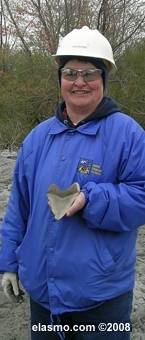 A couple of spectacular Carcharocles megalodon teeth were found. Matt Howard spent the better part of the day digging in a patch of Yorktown dirt that provided him two megs -- a three inch lower and a beautiful (but very dirty) 5-1/2 inch upper anterior. Kim Greene took an easier route to get her tooth; she crawled around to avoid the wind and spotted just one root ear of a 5-1/2 incher (Fig. E; click image to restore April Fools Day version). Her pleasure was doubled with also finding her first ever Parotodus benedeni. All other Carcharocles finds were small Pungo River specimens. A few nice mako and tiger shark teeth (Louise Crain got several) were found, as well a pretty Notorynchus by Frank Elder. Zandra Elder found a pathologic (twisted crown) Hemipristis upper. George Webb grinned from ear to ear as he cheerfully admitted to anyone listening, that after several trips to the mine, he still hasn't found a single shark tooth! He's anxious to try again. A couple of spectacular Carcharocles megalodon teeth were found. Matt Howard spent the better part of the day digging in a patch of Yorktown dirt that provided him two megs -- a three inch lower and a beautiful (but very dirty) 5-1/2 inch upper anterior. Kim Greene took an easier route to get her tooth; she crawled around to avoid the wind and spotted just one root ear of a 5-1/2 incher (Fig. E; click image to restore April Fools Day version). Her pleasure was doubled with also finding her first ever Parotodus benedeni. All other Carcharocles finds were small Pungo River specimens. A few nice mako and tiger shark teeth (Louise Crain got several) were found, as well a pretty Notorynchus by Frank Elder. Zandra Elder found a pathologic (twisted crown) Hemipristis upper. George Webb grinned from ear to ear as he cheerfully admitted to anyone listening, that after several trips to the mine, he still hasn't found a single shark tooth! He's anxious to try again.
Other Sunday finds included: 9.5 cm sperm whale tooth by Stacy Harvey, horse tooth by Zandra Elder, several complete Carcharodon carcharias and one mostly complete Squalodon molar. Teacher Clara Jo Elder bagged fossil coprolite "favors" for her students while Wesley Jacocks made several trips to the bus with whale fossils.
In spite of foul weather, the rosy-cheeked crowd lingered for a while in the parking lot before heading to the museum for a bit of reject pile collecting. It was a good day with great people.
Editor's comment: We incorrectly identified a bird bone image (Fig. 5) in last weekend's news. We had it as Pinguinus sp but Adam Smith advises it's actually an Alca stewarti humerus (that text has been corrected).
|
| |
| March 23, 2008 |
|
Weekend 4 - An Easter weekend parade through the Yorktown
Pat Young reports: Those scheduled for this weekend's hunt suffered jitters until word came late Friday that the fossil ramp, damaged by last Saturday's rain, had been repaired. The diversified group included members of the Dahlgren Fossil Club (VA), Indiana State University Earth Sciences Club (IN), Black River Fossil Club (SC) and several non-club affiliated fossil hunters. Both days were sunny and windy with Saturday in the mid-70's; Sunday began a chilly 38 degrees but had reached 65 by late afternoon.
The Easter tooth hunt rewarded Ken Young with the largest Carcharocles megalodon at 8:30 Saturday morning. His tooth (5-1/8"), a recent wash-out, was found in last season's tailings. Marco Gulotta, Sr. got the smallest, a 1/2 inch posterior C. chubutensis. Several very nice teeth in the 4+ inch range were found. The ISU-ESC students heavily worked Pungo tailings and most got at least one C. chubutensis.

 The Yorktown produced many freshly exposed Cosmopolitodus hastalis. Talban Kantala found Saturday's prize (3-1/8" upper) while Merrill Mille got a 2-1/2 incher on Sunday. Many others, only slightly smaller, were found. Eric Sadorf reported the season's first Hexanchus (Fig. A). Notorynchus and tiger shark teeth were heavily collected although large sand shark teeth still seem scarce. One Parotodus benedini tooth was found by Becky Hyne. Practicing the Pungo crawl also produced a nice Carcharoides catticus (Fig. C) for her; another collector showed one found in the parking lot. Carcharodon carcharias were found by Dan Furimsky (a 2" pristine black specimen), Eric Sadorf and Tom Breen (juvenile). A badly deformed meg was shown by George Oliver and a small split-tip tooth by Ditchweezil.
The Yorktown produced many freshly exposed Cosmopolitodus hastalis. Talban Kantala found Saturday's prize (3-1/8" upper) while Merrill Mille got a 2-1/2 incher on Sunday. Many others, only slightly smaller, were found. Eric Sadorf reported the season's first Hexanchus (Fig. A). Notorynchus and tiger shark teeth were heavily collected although large sand shark teeth still seem scarce. One Parotodus benedini tooth was found by Becky Hyne. Practicing the Pungo crawl also produced a nice Carcharoides catticus (Fig. C) for her; another collector showed one found in the parking lot. Carcharodon carcharias were found by Dan Furimsky (a 2" pristine black specimen), Eric Sadorf and Tom Breen (juvenile). A badly deformed meg was shown by George Oliver and a small split-tip tooth by Ditchweezil.
The many first-time visitors seemed in awe of the large whale vertebra and other marine mammal bones; most struggled under a heavy load. Several nice whale, dolphin and porpoise teeth were also collected. Squalodon teeth were reported by Ditchweezil, Talban Kantala, Reggie Titmas, BJ Blake and others. Seal fossils seem to be getting more common. Mel Gulotta's molar (Fig. B) was the first seen this season, but bones were found by Steve Noel, BJ Blake, Matt Rever and Jim White. Unusual fossils found this weekend include large bird bones by Adam Smith (Alca stewarti humerus, Fig. D) & Ditchweezil (Gavia sp. ulna, Fig. E), a barracuda vertebra by Steve Noel and a partial wahoo jaw containing several teeth by Matt Rever. Several persons, not previously acquainted with tube worms, collected buckets full of the larger ones.
Although shore birds are commonly seen feeding on minnows in mine waters, freshly deposited, barren hills offer little to attract gulls. This early migrant Laughing gull (Larus atricilla) was likely looking for eggs but had to settle for the few available cracker crumbs.
|
| |
| March 16, 2008 |
|
Weekend 3 - Rain, a Double-edged Sword
Pat Young reports: The final weekend of Friend's collecting began with a slightly cool Saturday morning that quickly warmed. No rain had fallen the previous week, but most counted on the large area to provide well.
The day's largest Carcharocles megalodon was found by Marlyn Allen; this 5-1/2 incher had a perfect crown but little root, suggesting the tooth was deposited prior to full development. Howie Cohn's meg (fig. b) and Katie Dodson's C. chubutensis (fig. d) were near-perfect examples of the many smaller Carcharocles found.

Cosmopolitodus hastalis were quite common with Chuck Ball, Brent McGuirt and Uwe Heine's being the largest (2-1/2"). Notorynchus teeth continue to be found regularly; while reaching for a lower nestled in some Pungo clam molds, Brian Roberts managed to find, only a few inches away, the season's first complete Echinorhinus tooth (fig. e). Some very large Hemipristis teeth were found, including a two-inch lower by Chuck Ball. Most other teeth seemed available in adequate numbers. James Kelly got a shark rostral node
As for Pungo marine mammal fossils: Judy Stiles (fig. a), Nancy Collins & Kevin Dye each found juvenile Squalodon teeth; William Kiser & Shannon Roberts large premolars and Charles Gillis an incisor. The Yorktown produced three five-inch sperm whale teeth and many smaller ones. John Timmerman picked up a seal astragalus that had been dug up then tossed back by another collector; he joked that apparently, it lacked enough enamel to be appealing. Other finds included whale vertebrae, nice periotics, limb bones and John Keklak's outstanding seal canine (fig. c).

Unusual fossils this weekend included Mike Keklak's cream-colored gompothere jigsaw puzzle (maybe a tooth someday), Howie Cohn's horse tooth and Harry Zirlin's horse conch (fig. f, the rarely seen at Aurora Fasciolaria cronlyensis). Scott Kusluch, Kevin Dye and Howie Cohn each found small chunks of amber.
For fossil collectors, rain can be a mixed blessing; it can open collecting opportunities or create less than desirable conditions -- the latter proved the case for Sunday's visitors. Heavy rain the night before eroded the ramp and mine safety required the visit to be cancelled. In spite of the long distances some had traveled and the morning's cool and windy wait, all appeared to accept the bad news with understanding spirits.
Editor's Comment: Having had the opportunity to finally collect this weekend, there are some beautiful Yorktown and Pungo River tailings; they certainly can use this rain and a few less footprints. Those scheduled for next weekend need to know that the ramp was severely eroded and only the unscheduled efforts of the mine to repair the access ramp will allow for entry next weekend. As of today (Monday) and if all goes well, the mine intends to have the ramp repaired for Weekend 4. -- Jim
|
| |
| March 9, 2008 |
|
Weekend 2 - The Lucky Sunday Slot
Pat Young reports: Sunday's group of visitors was larger than normal; included were those Friends collectors already in Aurora for the cancelled Saturday hunt. We experienced a bit of delay in getting to the mine, high winds prevented the ferry from running (making Becky a late arrival); we also needed three bus trips to get all in. The wind stayed with us throughout the day but the temperatures warmed considerably from the morning's low 30s to an afternoon high of 53-degrees. Although considerable rain had fallen on Friday and Saturday, the newer areas were reported mostly free of slippery clay. Today's collecting success proves that rain will be the key to keeping this new area refreshed.
Carcharocles was again the weekend warrior's battle cry. A few lucky people found easy pickings but most teeth were partially covered with mud (making picture taking a bit of a chore). Ken Volko started his meg hunting career right - he got the day's largest at 4-3/4 inches. Other good teeth were found by Jess Ferguson (4-1/2"), Lance McCormick (4-1/4" meg, Fig. A), Scott Roe (4-1/4"), Becky Hyne (4" lower), Larry Decina (3" chubbie, Fig. B), Rocky Culbertson (2" meg, Fig. E) and many others.
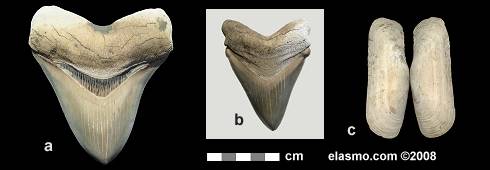
Two perfect Carcharodon carcharias were found. Robert Campbell, a first time Aurora collector, proudly showed off what was easily the prettiest tooth of the day -- his shiny black 2-1/4" C. carcharias (fig. F) was trimmed with a pale iridescent blue; Gregg Walden's was solid black. Cosmopolitodus hastalis collectors did very well with larger size teeth. The largest uppers (2-1/2") were found by Ken Valko and Ed Ternosky (Fig. G), but lower teeth were equally well represented. Only one Parotodus benedini was reported, a small Pungo posterior by Gregg Walden. Rain had really helped expose Notorynchus teeth; some collectors had three or more. Diane Gaines' lower was an unusually pretty one. John Williams added a new item to his fossil collection, a 6cm shark rostral node. If bulging baggies are any indication, I think it fair to say that most people got a generous take of both Pungo and Yorktown shark teeth today.

Among the other nice fossils collected, Ken Valko picked up the largest Ecphora quadricostata seen in a long time; it measured nearly six inches long and had a generous scattering of barnacles attached. Whale teeth were best represented by Lance McCormick's Pilot whale tooth (Fig. D, first of the season), Garrett Cooper's 6-inch sperm whale tooth, Karissa Hendershot's Squalodon incisor and Barb Roder's Squalodon molar. Cindy Muston collected a small ray dermal scute from the Pungo limestone; Yorktown examples were found by Dan Furimsky and Steve Balliet. Keith Robertson managed to find two associated walrus vertebrae. Whale vertebrae were heavily collected today but many more remain for anyone who cares to haul them out. The tiny amount of Flanner's Beach Fm. available managed to yield a rarely found articulated Tagelus plebeius carolinensis (Fig. C) and an unidentified echinoid.
|
| |
| March 7, 2008 |
|
Weather thoughts
For those of us making a long (and now very expensive) trip, cancellations although understandable are somewhat traumatic. I usually check the Weather Channel website's (http://www.weather.com/weather/local/USNC0027) 10-day forecast before departure. If morning T-storms are forecast for the particular day, it is likely access will be denied or the collecting day shortened. An alternate game-plan for a weekend is always a good idea. |
| |
| March 7, 2008 |
|
No collecting on Saturday
We've been advised that the forecast of thunderstorms and heavy rain has required the mine to cancel collecting on Saturday (only). |
| |
| March 2, 2008 |
|
Weekend 1 - An Impressive Start
Pat Young reports: The first weekend of the spring fossil collecting season at PCS is always a fun and energetic meeting of like-minded people. Those from the south are happy for a bit of cooler, drier weather, while the northern contingent is happy to be away from cold and snow for a few days. Saturday's winds were a bit brisk; both days started with pleasant cool mornings (40's) followed by warm (60's) afternoons. Curtis Ormond, Sr. of PCS Public Affairs stopped by to wish us a productive season. Becky and Candace are back as Team Leaders but new this year is the requirement of a Liability Release. In spite of the extra paperwork, we still managed to get to the mine at 8:45am. Friends of the Museum filled this weekend's slots.
Surprisingly, a few collectors chose to spend the day in last season's soils. Several months of erosion have exposed nice smaller fossils, including fish otoliths, cetacean fossils (including teeth and earbones) and small shark teeth. From this area, Mary Frances Comer brought out a complete cetacean occipital. The new area provided much more generously; most collectors had a nice bag of shark & whale teeth, bones and some extremely large pieces of coral. The sheer bulk of the day's collecting bounty didn't allow me to view more than a small portion of the day's material.

Carcharocles megalodon is the most highly sought fossil at Aurora and many collectors were not disappointed. Show and tell, being the hectic event it is, proved an obstacle to getting an accurate count of both days' total take. I think it's fair to say that most collectors had a meg or chubutensis of some size or condition in their bags. Most of the Yorktown teeth seen were covered with wet dirt and only recovered by diligent searching. Among the largest "megs" seen were those found by: Bill Killen (he also got a 3-1/2 & 2 inch posterior), Matt Howard & Jeff Sparks (5"), Jason Kowinsky (4-3/4"), Shannon Roberts, Lee Cone (Fig. B), Paul Murdoch (Fig. A) (4-1/4"), Matt Rever, Paul Sangeorzan (4") and posteriors by Fred Plumb and Kyle Grimsley. BJ Blake found three small megs within a 3-foot area. Parotodus benedini, the other Aurora tooth with a cult following, was represented by 'only' three specimens: Matt Howard (fig. C) and Paul Sangerozan got Yorktown teeth (2-1/2") while Kevin May showed a shiny black specimen (1-3/4"). An attempt at documenting the numerous Notorynchus teeth was quickly abandoned; some people found four but no symphyseals showed up. A lone Carcharodon carcharias was shown by Bonnie Chaussee (Fig. E). Among the other teeth of note -- Doug Chaussee found two Isurus retoflexus laterals, Louis Kohler a posterior echinorhinid and Candace a pretty Alopias sp. Carol Homon got the only pathologic tooth, a meg with wierd abnormal growths on the crown. Ray dermal scutes were in mostly good condition, Jim White and Doug Chausse each found three but many others (including Candace's, Fig. F) were reported.

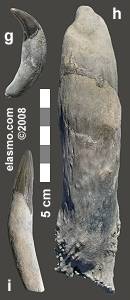 The Pungo Fm. produced two fairly rare items; a small section of gompothere tooth by Paul Murdoch and three chunks of amber (George Klein, Glenn Talley and Joel Hardin). A Squalodon molar was picked up by Paul Murdoch while Fred Plumb, Gary Thorne (Fig. I) and Chuck Ferrara got incisors. Sperm whale teeth were generally in good condition and plentiful; Candace Holliday dug out four associated ones and Jason Kowinsky's (Fig. H) was particularly nice and clean. Other fossils from this weekend included: seal incisors (John Everette, Shannon Roberts (Fig. G), lower Tautog pharyngeal toothplate (Fred Mazza, Fig. D), 7" Marlin rostrum (Lee Cone), bird bones (Bill Killen, Matt Rever and Marco Gulotta, Sr.) and a nice shark-bitten caudal vertebra (Robert Story). Bill Heim identified a 2-5/8" diameter shark vertebra found by Marco Gulotta, Jr. as likely Galeocerdo cuvier. This list could go on extensively but a fair assessment is that every one returned with an abundance of fossil goodies; the results required three bus trips at day's end. The Pungo Fm. produced two fairly rare items; a small section of gompothere tooth by Paul Murdoch and three chunks of amber (George Klein, Glenn Talley and Joel Hardin). A Squalodon molar was picked up by Paul Murdoch while Fred Plumb, Gary Thorne (Fig. I) and Chuck Ferrara got incisors. Sperm whale teeth were generally in good condition and plentiful; Candace Holliday dug out four associated ones and Jason Kowinsky's (Fig. H) was particularly nice and clean. Other fossils from this weekend included: seal incisors (John Everette, Shannon Roberts (Fig. G), lower Tautog pharyngeal toothplate (Fred Mazza, Fig. D), 7" Marlin rostrum (Lee Cone), bird bones (Bill Killen, Matt Rever and Marco Gulotta, Sr.) and a nice shark-bitten caudal vertebra (Robert Story). Bill Heim identified a 2-5/8" diameter shark vertebra found by Marco Gulotta, Jr. as likely Galeocerdo cuvier. This list could go on extensively but a fair assessment is that every one returned with an abundance of fossil goodies; the results required three bus trips at day's end.
|
| |
| February 25, 2008 |
|
Stakes Set
Pat Young reports: While setting stakes yesterday for the spring season, I got a good preview of the new collecting area.
We'll be using last season's ramp to enter the mine. All areas to the right of the bulldozer ramp are now off-limits due to water accumulation. This season's collecting space includes all the area collected last season to the left of the ramp and extends to three windrows from the dragline (about 9 windrows in all). The area is huge and requires a lot of walking to get to the far side and rear. On the plus side, there is very little water in the newer area so back-tracking to get to the bus should not be an issue this season. The boundary lines are well marked with blue surveyor's tape on white stakes on the left and rear of the area while the bulldozed ramp will form a right side boundary.
Unit 2 Yorktown is abundant -- there are nice rain-washed gullies filled with whale fossils (vertebrae, ribs, flipper bones and skull parts are everywhere). The Pungo limestone tailings seem equally promising -- washed enough that even quick, casual glances revealed smaller teeth. Lower Pungo sands were littlered with nice fish fossils. The upper Yorktown shell bed is minimal in this new area but should be plenty large enough for those inclined to hunt it.
Burdened with several heavy loads of stakes and a hammer, we had no time or energy to hunt the area (I never saw a "meg") , but all indications are that it should be one the best seasons we've had in a long time. We're still in drought mode, but this type of material needs only a slight bit of rain occasionally to keep it fresh.
Cross your fingers! We should have some good reports this season. |
| |
| February 23, 2008 |
|
Black Creek Update
Last summer, Kim Greene found an interesting Castle Hayne Fm. (Eocene) site in Wayne Co., NC; with Howie Cohn's help, we've made several collecting trips. Expecting to supplement the then new Castle Hayne page, we were surprised to find that it was predominated with Cretaceous material (some of which had not been previously reported from NC). These initial finds cascaded into a need to update the Black Creek (Cretaceous) fauna page and a dozen or two genus pages (some new). This project has now been finally synthesized in an updated Black Creek webpage; major revisions are also reflected on the
Cretalamna,
Cretoxyrhina,
Scapanorhynchus,
Squalicorax and other genus pages. |
| |
| February 20, 2008 |
|
Slots Awarded
As most should know by now, Friends and general slots have been awarded for the Spring Season. Collecting will begin March 1st (with the first three weekends going to the Friends) and continue through May 11th.
The mine has had little rain since the Fall Season ended; but Monday, it received nearly three-inches. A few more good downpours should help replenish the surface 'fauna'. An attempt will be made to have a new ramp (closer to the dragline) in-place before the season begins. Their are no new 'rules' for this season, so be out there by 7:30 with steel-toed shoes, long pants and hard-hat. |
| |
| January 16, 2008 |
|
Ptychodus mortoni citation
It appears that the citation for Ptychodus mortoni as used on the website (and many other places) has been incorrect. Earl Manning argues that 1839 is the proper date and his logic would appear to be valid. If this topic is of any interest, take a look at his reasons. |
| |
| January 14, 2008 |
|
Spring Season Confirmed
Curtis Ormond emailed me today that a Spring Season has been approved and "I will accept requests emailed after midnight tonight.Requesters must put the number of slots they are requesting and any contact information. I will not be able (due to the volume of emails coming in) to respond to each email, but I will make every attempt to have the schedule complete by the middle of February and will respond to them then." |
| |
| January 3, 2008 |
|
Spring 2008 Season
Plans for a spring collecting season at PCS have not been finalized, but Curtis Ormond will begin taking emails for collecting slots between the dates of January 15th and January 31st. If you have previously sent a request, you'll need to re-send between those dates to be considered. As in past years, Friends of the Museum will get the first few weekend's slots. As more information becomes available, it will be announced. |
|
|